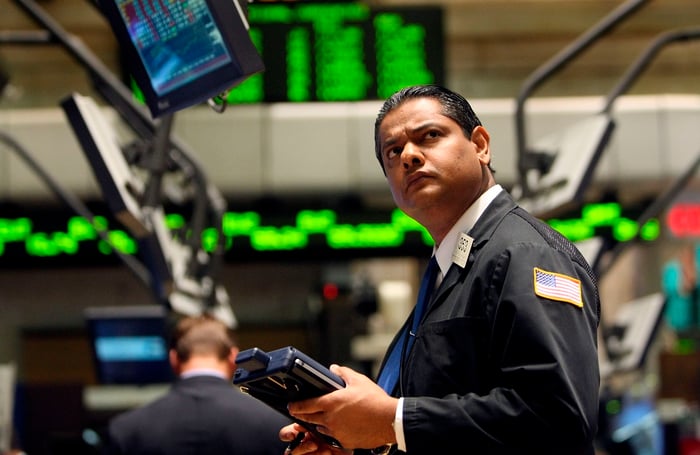This year has clearly demonstrated how the stock market can be a powerful engine for building wealth for those who are willing to wait. Even though stocks took a hit due to tariffs in late March and early April, the S&P 500 ( ^GSPC -2.71%), the enduring Dow Jones Industrial Average ( ^DJI -1.90%), and the innovation-focused Nasdaq Composite ( ^IXIC -3.56%) have all managed to reach multiple new record closing levels.
Investors have plenty to look forward to, such as advancements in artificial intelligence (AI), the development of quantum computing, the possibility of interest rate reductions in the future, and an eventual decision regarding President Donald Trump's tariffs. Any factor that brings more predictability to Wall Street is typically highly prized by investors.
However, the recent all-time highs for the S&P 500, Dow Jones, and Nasdaq Composite are not the only noteworthy events. The stock market has just accomplished something that has only happened three times (including this latest occurrence) since January 1871. Historical trends suggest this may not bode well for stocks in the near future, whether over the next several quarters or years.

Image source: Getty Images.
The stock market just made history -- but not the good kind
While headlines focus on the new highs for the S&P 500, Dow, and Nasdaq Composite, the story behind stock valuations is just as significant.
To clarify, there is no universal method for assessing the value of individual stocks or the entire market. Each investor has their own perspective and criteria for what constitutes a bargain or an expensive stock, which is part of what makes the market so unpredictable.
Despite this subjectivity, there is one valuation measure that is virtually foolproof. This metric allows us to compare the S&P 500’s relative value over more than 150 years, providing a consistent benchmark. This is the well-known Shiller price-to-earnings (P/E) ratio, also called the cyclically adjusted P/E (CAPE Ratio).
The Shiller P/E stands apart from the standard P/E ratio because it considers a broader earnings history. While the traditional P/E divides a company’s share price by its earnings per share over the past 12 months, the Shiller P/E uses the average inflation-adjusted earnings per share from the previous decade. By factoring in and adjusting for inflation over ten years, this metric remains useful even during periods of economic shocks or recessions.
Looking back 154 years to January 1871, the average Shiller P/E for the S&P 500 has been 17.29. Notably, for much of the past three decades, this ratio has been above its long-term average, reflecting the impact of the internet making information more accessible and the downward trend in interest rates throughout the 2010s.
S&P 500 Shiller CAPE Ratio data by YCharts .
However, history shows that there are limits to how high these valuation premiums can go.
On October 8, the S&P 500’s Shiller P/E reached 40.32, marking the highest point in the current bull market, which began three years ago. This figure is also 133% higher than the 154-year average.
What’s truly striking is comparing this recent peak of 40.32 to previous highs during other uninterrupted bull markets.
Since 1871, the S&P 500’s Shiller P/E has only exceeded 40 on three occasions:
- In December 1999, driven by the excitement of the internet boom, the Shiller P/E hit its all-time high of 44.19.
- In the first week of January 2022, with consumers flush from fiscal stimulus, the Shiller P/E briefly surpassed 40.
- On October 8, 2025, it reached the previously mentioned high of 40.32.
Although we cannot predict the future with certainty, history is very clear about what tends to follow such peaks. After the December 1999 high, the S&P 500 and Nasdaq Composite lost 49% and 78% of their value, respectively, by 2002. Similarly, the S&P 500 dropped 25% during the 2022 bear market.
In fact, since 1871, there have only been six times when the Shiller P/E has stayed above 30 for at least two months during a sustained bull market. Each of the previous five instances led to declines in the S&P 500, Dow, and/or Nasdaq Composite ranging from 20% to as much as 89%.

Image source: Getty Images.
Though short-term disaster awaits (based on history), the long-term future for stocks is bright
Looking strictly at historical patterns, the major stock indexes on Wall Street appear to be heading toward a significant downturn. While the Shiller P/E doesn’t indicate exactly when a correction or bear market will begin, it does show that the market struggles to sustain elevated valuations for long periods.
However, history also provides reasons for optimism.
On the one hand, the historical record shows that market corrections, bear markets, and even sudden crashes—like the one in early April—are normal and unavoidable parts of the investment cycle. No amount of government spending or monetary policy can fully prevent these declines.
Yet, nearly a hundred years of data reveal that Wall Street’s steepest declines—those of 20% or more—tend to be relatively brief.
When the S&P 500 officially entered its current bull market in June 2023 (having climbed 20% from its October 2022 low), Bespoke Investment Group shared a data set on X (formerly Twitter) comparing the duration of every S&P 500 bull and bear market since the Great Depression began in September 1929.
It's official. A new bull market is confirmed.
-- Bespoke (@bespokeinvest) June 8, 2023
The S&P 500 is now up 20% from its 10/12/22 closing low. The prior bear market saw the index fall 25.4% over 282 days.
Read more at https://t.co/H4p1RcpfIn . pic.twitter.com/tnRz1wdonp
Bespoke analyzed 54 instances in total (27 bull markets and 27 bear markets) and found a notable difference in the average duration of upward and downward moves in the S&P 500. As of June 2023, the typical bear market lasted just 9.5 months (286 days), while the average bull market continued for roughly two years and nine months (1,011 days).
Additionally, Bespoke’s research shows that the longest S&P 500 bear market since September 1929 lasted 630 days. If the current bull market were to continue to the present, it would be the 14th out of 27 bull markets to last longer than 630 days.
Statistically, stocks may face trouble in the near term. But over the span of decades, history makes it clear that long-term investors are well positioned to see their wealth grow.